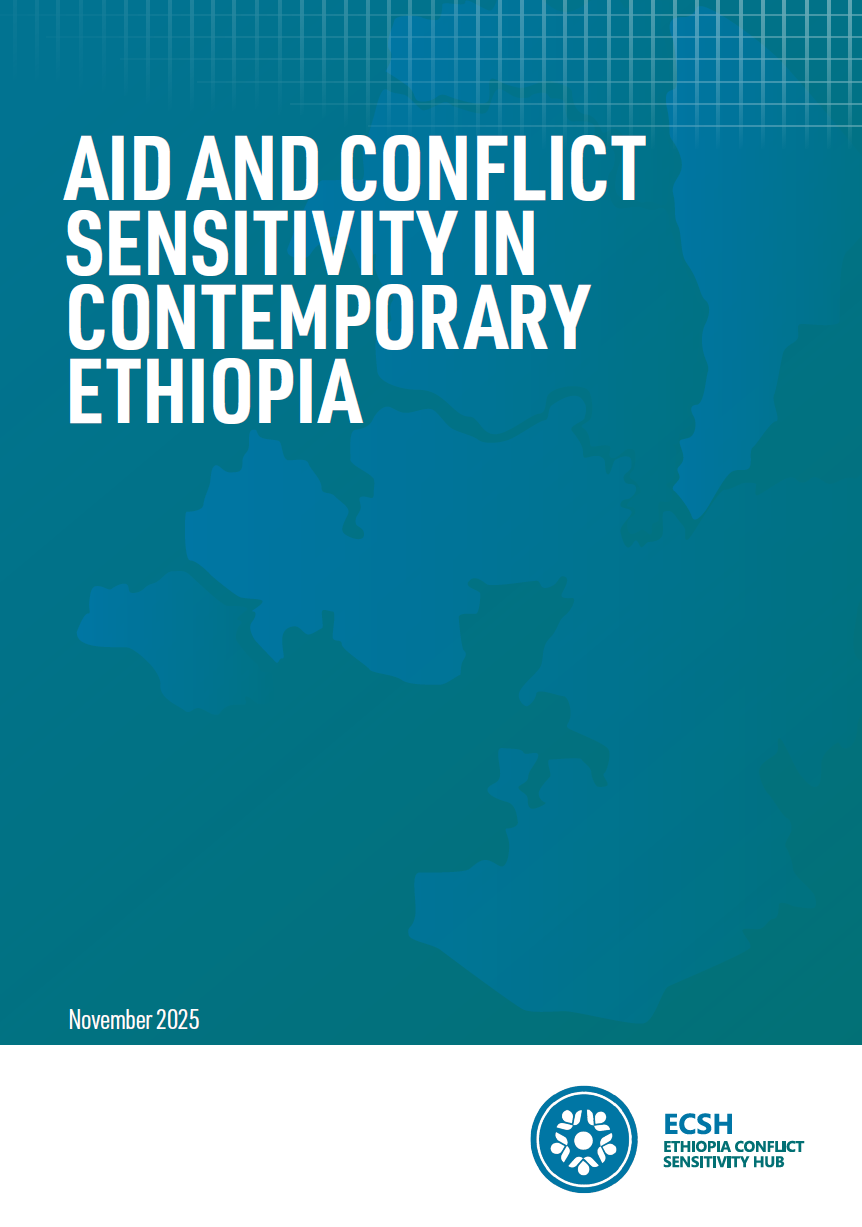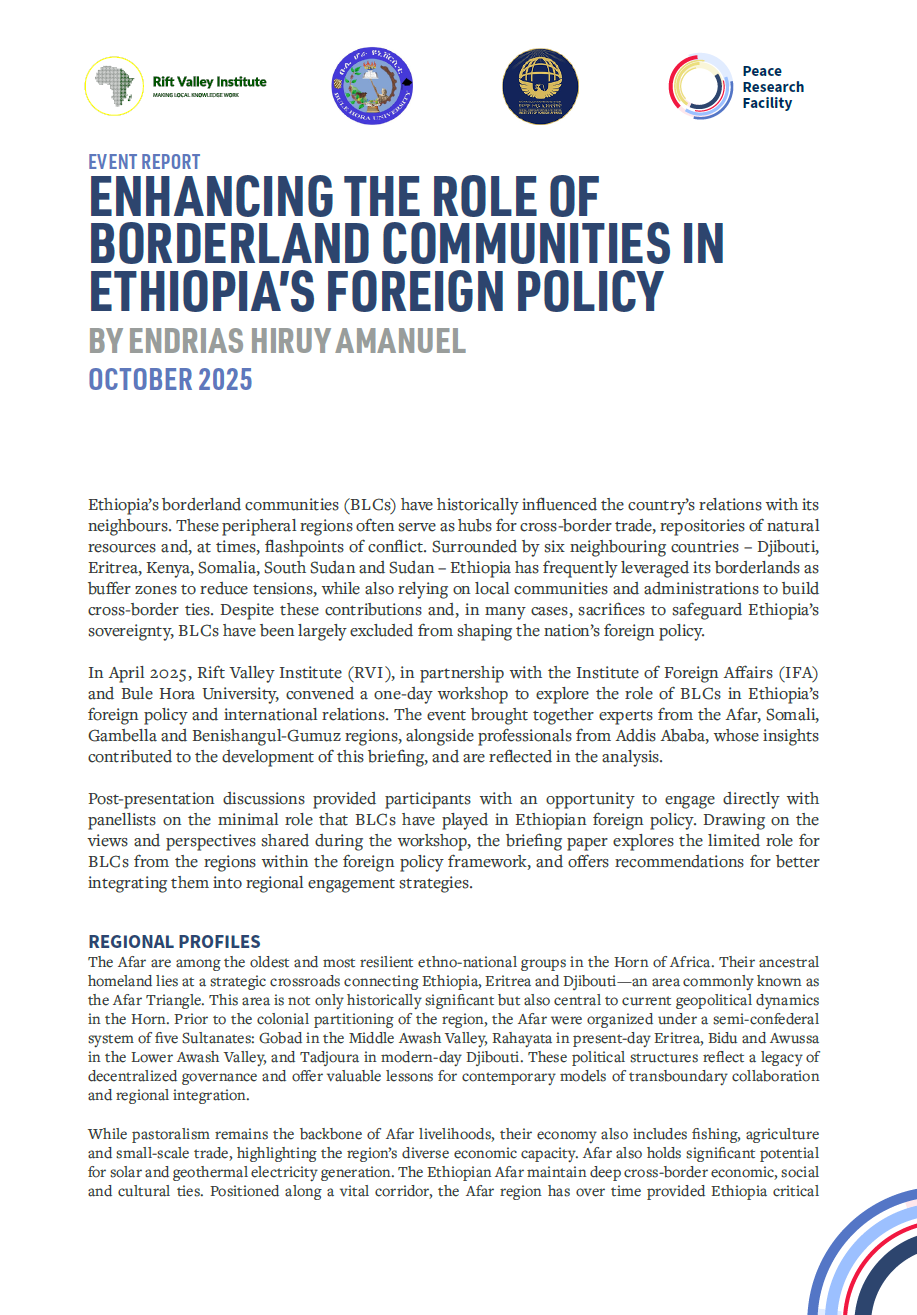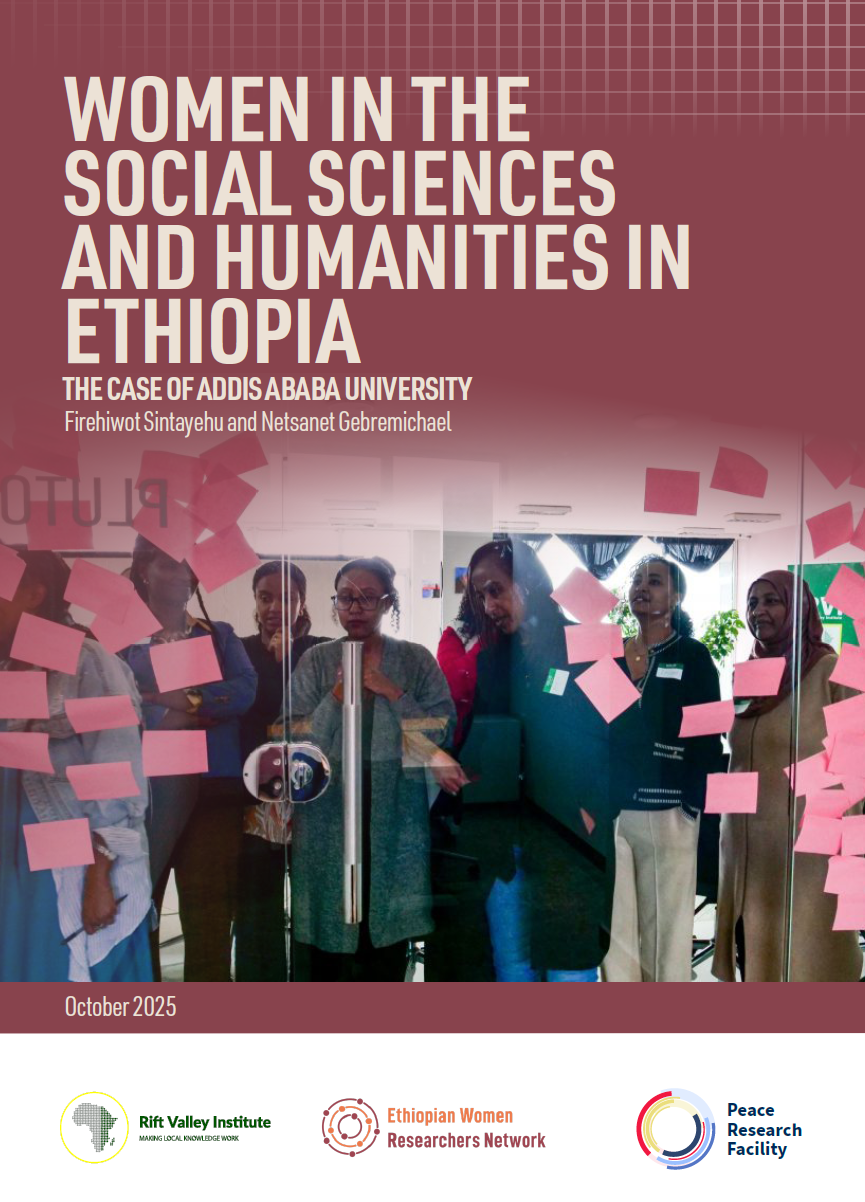This blog post was written by Michael Woldemariam and Jutta Bakonyi, the Co-Directors of Studies for the Rift Valley Institute’s Horn of Africa Course, which will be taking place in Ethiopia from 17-21 June 2019. Michael and Jutta will be joined by a team of leading specialists to explore the contemporary complexities of the region as well as the gamut of social, economic, political and security trends, drawing on deep history and local knowledge to inform debate and discussion. The courses are designed for policy-makers, diplomats, investors, development workers, researchers, activists and journalists—for new arrivals to the region and those already working there who wish to deepen their understanding.
The past year has seen unprecedented changes in the Horn of Africa. These followed the appointment of Abiy Ahmed as Prime Minister of Ethiopia in April 2018, who set about a series of internal reforms, as well as brokering a rapprochement between Ethiopia and Eritrea. This was coupled with the continuing involvement of the Gulf states in the Horn’s politial processes, with particular influence in Somalia. Abiy’s energetic interventions have raised hopes of a new era of closer and more constructive regional relations, but significant challenges remain. These include the failure to institutionalize the peace process with Eritrea and consolidate a broader regional political settlement. Meanwhile, serious domestic threats to stability in Somalia and Ethiopia persist and internal reform in Eritrea remains elusive. While change is certainly afoot in the Horn, its outcomes remain ambiguous.
Gulf crisis forces Horn of Africa to pick sides
The fallout from the Gulf Crisis—pitting Saudi Arabia, the United Arab Emirates (UAE) and their allies against Qatar and Turkey—has continued to influence events in the Horn of Africa. Offers of patronage in exchange for influence and control over strategic assets have created incentives for the region’s powerbrokers to pick sides.
Ethiopia has been most able to resist such pressures, although it has strengthened its ties with the UAE and Saudi Arabia. In contrast, the Federal Government of Somalia (FGS), despite claims of neutrality, has sided with Qatar and Turkey. This has added to existing friction with various sub-national entities, which have chosen to maintain or strengthen their ties with the UAE.
With the establishment of a UAE military base at the port of Assab in 2015, and the departure of Qatari peacekeeping forces from its disputed border with Djibouti in 2017, Eritrea remained firmly allied with the UAE and Saudi Arabia. Meanwhile, Djibouti’s position is more complicated. It initially sided with the Saudi-Emirati axis in 2017, prompting the breakdown of diplomatic relations with Qatar and departure of the peacekeeping force. However, Djibouti’s relations with the Emirates have deteriorated since the cancellation of a contract with Dubai Ports World (DP World) to operate its main container terminal—a decision made in favour of closer ties with China.
As the increase in tensions between Somalia’s federal government and member states demonstrates, the spill-over of Gulf rivalries into the Horn can be a destabilizing force. This being said, Saudi Arabia and the UAE successfully brokered the Ethio-Eritrean rapprochement, demonstrating how the expanding influence of cash-rich Gulf states might carry some benefits for the region. Indeed, the UAE’s investment in a number of key ports has raised the possibility that the Gulf may also serve as a catalyst for regional economic integration.
Abiy Ahmed’s Ethiopian spring
Within Ethiopia, the appointment of Abiy Ahmed as prime minister in April 2018 represented a tectonic shift within the Ethiopian People’s Revolutionary Democratic Front (EPRDF) ruling coalition. A budding alliance between the Oromo People’s Democratic Front (OPDO) and Amhara National Democratic Movement (ANDM) has succeeded in displacing the Tigray People’s Liberation Front (TPLF) as the dominant political force.
Abiy and his allies acted swiftly to reorient what was an increasingly authoritarian political system. Political prisoners were released, exiled activists and opposition groups invited to return home, and onerous media restrictions lifted. Abiy has sought to reshape the Ethiopian state, removing and rotating key officials, and restricting the powers of the state security apparatus. He has insisted that sweeping reforms are necessary to restore public confidence, promote reconciliation, and boost national unity. This has been met some resistance from within the EPRDF.
Amid these changes there have been serious challenges. Ethnic violence has erupted in various parts of the country, causing displacement and humanitarian crisis. By the end of 2018, more than a million Ethiopians had been forced from their homes. Even in regions that have not witnessed significant conflict or mass displacement, such as in the Amhara and Tigrayan borderlands, intercommunal tensions present a growing threat to security. The drivers of ethnic conflict are varied. Political liberalization has removed the lid from previously suppressed ethnic cleavages and provided ethno-political entrepreneurs the space to mobilize.
The EPRDF coalition is increasingly fragmented and state institutions eroded, which has called into question the meaning and design of Ethiopia’s ethnic federal system and, significantly, its ability to manage, suppress and respond to local conflicts. Newly repatriated non-state armed forces—particularly the Oromo Liberation Front (OLF)—are adding to this volatile mix.
The precise contours of the government’s economic policies have yet to be defined, but a departure from the statist orientation of its predecessor is clear, with the privatization of state monopolies in telecoms, commercial aviation, and energy now contemplated. Private sector growth and foreign direct investment, rather than government consumption, appear to be the intended engines of economic growth.
Ethiopia’s debt burden, however, remains high and hard currency shortages are chronic. A youth bulge and the expansion of tertiary education has created serious pressures on the labour market. Migration flows, partly as response to these dynamics, are rendering thousands of young Ethiopians vulnerable to predation in Yemen, Sudan and Libya.
Internal reform in Eritrea as yet unseen
Since the border war in 1998, rivalry with Ethiopia has defined Eritrea’s domestic and regional policy agenda, driving its slide deeper into autocracy, economic dysfunction, militarization and, as a consequence, international isolation and the mass migration of its youth. The diplomatic breakthrough with Ethiopia prompted the removal of UN Security Council sanctions in November 2018, which relieved Asmara of an arms embargo that had been in place since 2009.
While there have been some positive results for Eritreans—the price of staple goods has generally dropped—nearly a year on there is no indication that meaningful economic and political reform is on the horizon. The system of indefinite and low-wage national service persists, political prisoners remain in detention, and the climate of repression and fear remains intact. In the months following the September 2018 border opening, thousands of Eritreans fled the country—a trend that has been partly attenuated by a re-closing of the border crossings in early 2019.
It remains unclear how long President Isaias can preserve the political monopoly he has enjoyed since the 1990s. The rapprochement with Ethiopia, as well as strengthened ties with the UAE and Saudi Arabia, have eased some external pressures, but popular protest and political transformation in neighbouring Ethiopia and Sudan may still spill-over. A rising tide of discontent among the broader public is evidenced by a surge in anti-government activity online and in the diaspora, notable symbolic acts of defiance inside the country and reports of internal discontent within the ruling People’s Front for Democracy and Justice (PFDJ). Pressure for change is building, but a wide range of potential outcomes appears possible.
Somalia’s security challenges continue
Mohammed Abdullahi Mohamed ‘Farmajo’ is a little over half-way through his mandate as president of the Federal Government of Somalia. The country continues to be shaped by massive security challenges and in-fighting among the political elites. Tensions between the Federal Member States and the federal government have continued over the past year.
Attempts by the federal government to manipulate regional electoral processes in South West State and Puntland had mixed results. In South West State, when former al-Shabaab leader Mukhtar Robow announced his plans to run for office—gaining considerable local support—he was arrested by the federal forces. The federal government’s favoured candidate, Abdiaziz Hassan Mohamed ‘Lafta Gareen’, backed by financial resources from Mogadishu, subsequently won. The arrest of Robow caused street protests in Baidoa during which 15 people were killed. After criticizing the arrest of Robow and handling of demonstrations, the head of the United Nations Assistance Mission in Somalia (UNSOM), Nicholas Haysom, was declared persona non-grata by the federal government in January 2019.
The federal government failed to secure victory for their preferred candidate in Puntland in January 2019. The new regional president, Said Abdullahi Deni, has adopted an increasingly critical tone towards the federal executive in the first half of 2019.
The federal government has made only modest progress in reform of the security sector. The Somali National Army (SNA) remains fragmented and the mandates, chain of command, and loyalties of central and regional security forces remain unclear. The African Union Mission in Somalia (AMISOM) has reiterated plans to gradually hand over security provision to the national army and withdraw in 2021. The federal government and most of the states, however, remain entirely dependent on AMISOM to maintain control over urban centres.
Harakat al-Shabaab al-Mujaahidiin (al-Shabaab) remains entrenched in much of the Somali countryside and continues to conduct sophisticated attacks in urban centres and on military bases, as well as carrying out regular targeted assassinations. In January 2019, the group conducted its first major attack outside of Somalia since 2015, killing 24 people in an assault on a business complex and hotel in Nairobi, Kenya. Despite an uptick in targeted airstrikes against al-Shabaab leaders by international forces, the group’s ability to conduct attacks remains largely unaffected.
Somalia remains highly vulnerable to humanitarian crises. Lower than expected rainfall in late 2018 and drier than normal conditions in early 2019 have led to drought conditions, particularly in southern Somalia and Somaliland. In May 2019, UN officials warned of an evolving humanitarian crisis if further action were not taken swiftly. In the first quarter of 2019 alone, an estimated 137,000 people were displaced by conflict and drought.
Somaliland’s politics and security fray at edges
In Somaliland, parliamentary and municipal elections scheduled for April 2019 were once again postponed. Somaliland, which successfully organised three presidential elections in 2003, 2010 and 2017, has so far only held one parliamentary election, in 2005. Relations between Somaliland and Ethiopia initially appeared strained by Addis Ababa’s rapprochement with Mogadishu, but has subsequently been rekindled, not least because of Ethiopia’s interests in developments at the port of Berbera, on the Somaliland coast. The UAE’s investments remain a source of dispute between the federal government and Somaliland administration.
In the contested eastern border regions of Somaliland and Puntland, conflicts intensified during the year leaving an estimated 12,500 civilians displaced. Somaliland and Puntland regional forces have been in a standoff since May 2018 near the town of Tukaraq in the disputed border regions, and attempts by the UN, regional organisations and elders to mediate have so far failed.
Djibouti profits from strategic location
Located at the confluence of the Red Sea and the Indian Ocean, Djibouti’s economy is largely dependent on port revenues—it has served as the primary conduit for Ethiopia’s international trade since it lost access to Eritrean ports in 1998—and from hosting international military bases. Djibouti has developed into a logistical hub for military operations in East Africa and in support of anti-piracy and counter-terrorism operations.
Djibouti is also crucial to China’s Belt and Road Initiative, and Chinese companies have already built the Doraleh multipurpose port and are currently building and financing the Djibouti International Free Trade Zone. China’s position as Djibouti’s most important development partner were consolidated in 2018 with the opening of the first Chinese overseas military base adjacent to the Doraleh port facilities.
Djibouti remains a key transit point for migration out of Africa. Over the last two years, an estimated 200,000 African migrants, primarily from the Horn, have used Djiboutian territory to cross into Yemen.
Urbanization key to the Horn’s political future
Amidst these short-term political shifts, the issue of rapid urbanization is shaping the future of many of the Horn’s people. This has increased pressures on already limited resources in the region’s cities and is transforming what were largely rural societies.
Over a fifth of Ethiopia’s 110 million people now live in urban and peri-urban areas. The expansion of Addis Ababa, and encroachment into the Oromia region, fed into the Ethiopian protest movements that erupted in 2016, and ultimately led to the resignation of former Prime Minister Hailemariam Desalegn and elevation of Abiy Ahmed, with wide-ranging consequences for the region.
Haphazard, rapid urbanisation in the Horn of Africa will likely present an increasing threat to stability in an already fragile environment. For this reason, RVI’s 2019 Horn of Africa course will pay particular attention to the drivers, risks and potential benefits of urbanisation, which have influenced many of the political processes described above.



